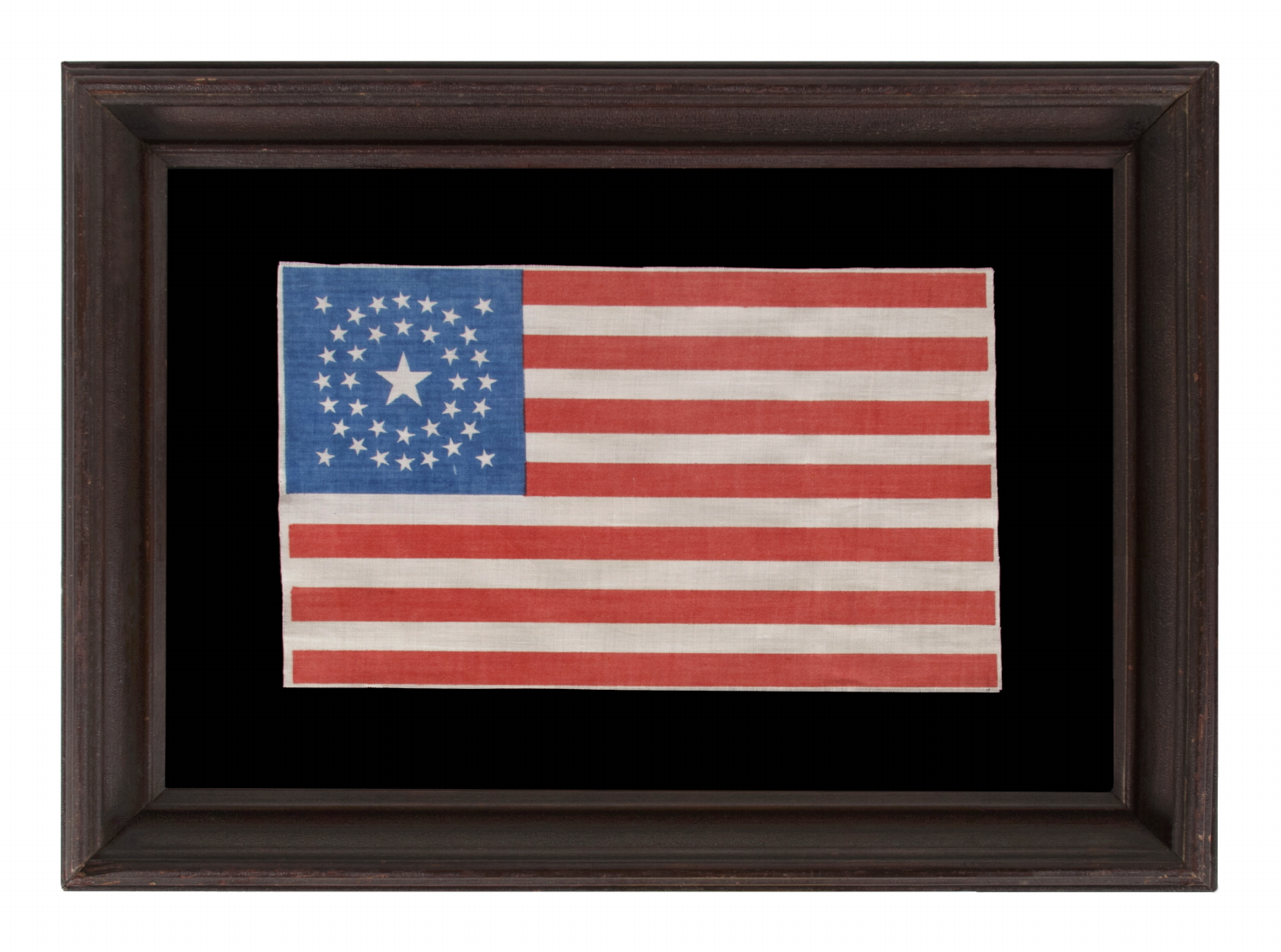
| |
37 STAR ANTIQUE AMERICAN FLAG WITH A DOUBLE-WREATH CONFIGURATION, PROBABLY MADE FOR THE CELEBRATION OF THE CENTENNIAL OF AMERICAN INDEPENDENCE IN 1876, REFLECTS THE TIME DURING WHICH NEBRASKA WAS THE MOST RECENT STATE TO JOIN THE UNION |
|
| Available: |
Sold |
| Frame Size (H x L): |
Approx. 9" x 13" |
| Flag Size (H x L): |
6" x 10" |
|
| Description....: |
|
37 star American national parade flag, printed on plain weave cotton. The stars are arranged in a double-wreath form of the medallion pattern. This consists of a large center star, surrounded by two wreaths of smaller stars, with a star in each corner of the blue canton.
Nebraska joined the Union as the 37th state on March 1st, 1867. The 37 star flag was official from that year until 1877, although it generally fell from use in 1875 or 1876 with the impending addition of more states. The 37 star-count is quite scarce in comparison to the flags that immediately preceded and followed it. This is due primarily to the lack of major patriotic events during the period they were used, which followed the Civil War, yet preceded the 1876 anniversary of American independence, and encompassed most of Southern Reconstruction. While the 37 star flag was still official in 1876, it was well known that at least one more state would be joining the Union that year. This caused flag makers to generally cease production in favor of 38 and 39 star flags, as well as 13 star flags to commemorate the 13 original colonies.
Parade flags were printed on bolts like any other fabric. I have seen pieces of this exact type of 37 star flag used in the piecework design of quilts made to celebrate the 100-year anniversary of American independence in 1876. It is of special interest to note that this exact type of 37 star flag is known to have been printed alongside the 14 star flags of similar scale, together on the same bolt of fabric, with alternating placement. This was common in the production of some varieties of parade flags.
Flags in this 37 star variety actually appear alongside the 14 star variety in all three quilts. In addition, another quilt was discovered that had uncut bolts of fabric with both styles of flags inside it, being used for stuffing. It is logical to assume that this occurred after the 37 star count was no longer accurate.
It seems likely that the 14 star flags had the incorrect star count. Most likely these were instead intended to have 13 stars, to reflect the original 13 colonies. This was an expected star count at the 1876 centennial (as well as at other patriotic times in American history). It is also surprising that the flag-maker maker of these flags didn’t add a 38th star to the official count of 37. Most flag-makers were doing this in 1876 to reflect the upcoming addition of Colorado, which joined the Union as the 38th state in August of that year. Some were also adding a 39th star, in anticipation that yet another Western Territory, Dakota, would soon become the 39th state. Flag-makers paid little heed to official star counts. Most simply wished to be one-up their competitors in hopes to sell more flags.
In spite of these facts, some 37 star flags survive with hand-inscribed or embroidered dates, that were evidently used in the fanfare of the centennial. In addition, various other patriotic textiles survive that display counts of 37 stars and are likewise known to have been produced specifically for our 100th anniversary.
Because the centennial celebration fueled all manner of elaborate decorations, I have long presumed that some of those with more fanciful star configurations, such as the one in question here, were produced specifically for that purpose.
Mounting: The solid walnut molding dates to the period between 1870 and the 1880's and retains its original varnished surface. We maintain our own textile conservation department, where, for the past 20 years, we have taken great care in the mounting and presentation of flags, preserving and framing thousands of examples. In this particular instance, the flag has been hand-stitched to 100% cotton, black in color, that was washed and treated to reduce and set the dye. Spacers keep the textile away from the glass, which is U.V. protective.
Condition: Excellent. |
|
|
|
| Collector Level: |
Intermediate-Level Collectors and Special Gifts |
|
| Flag Type: |
Parade flag |
|
| Star Count: |
37 |
|
| Earliest Date of Origin: |
1876 |
|
| Latest Date of Origin: |
1876 |
|
| State/Affiliation: |
Nebraska |
|
| War Association: |
1866-1890 Indian Wars |
|
| Price: |
SOLD |
|
| |
Views: 783 |
|
|
|

